Canon offers a wide array of excellent lenses that are especially useful for photographing animals — both wild and domestic. There are many choices that fill most needs and budgets. And quite often animals are more active on darker cloudy days or early and late in the day. Since the light is dimmer under these conditions, having a lens with a wider maximum aperture (f/4.0 or wider, such as f/2.8) is often advantageous.
Let’s look at the various lens choices that work well for animal photographers and explain the options. If you use an interchangeable-lens camera with a smaller, APS-C size sensor (like a Canon EOS Rebel series or EOS 7D series model), with a crop factor, you can often achieve similar results with less-expensive, shorter focal length lenses than with what's required if you use a camera with a full-frame image sensor. Let’s look at many, but not all, of the options first, and then explain the lenses most used by serious animal photographers and conclude it with my choices and why I use them.
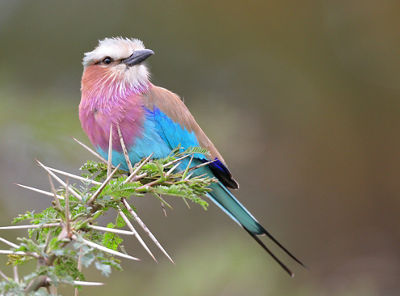
Focal Length
At a minimum, select a lens with at least a 300mm focal length, either a prime lens such as the Canon 300mm f/4.0, or a zoom lens like the Canon 70-300mm. Both work well when the subject allows close approach. When these lenses are used with a Canon camera that has a small sensor, the lens seems much longer because the image is already cropped at the image sensor and in the camera’s viewfinder. For example, the Canon EOS 7D Mark II, digital Rebel models, and many others in the Canon line have a crop factor of 1.6x due to the smaller size sensor used. In effect, this gives the lens a field of view that is equivalent to 1.6 times the lens’ actual focal length. A 300mm f/4.0 fills the viewfinder considerably more due to the cropping of the smaller sensor in a Rebel or 7D Mark II. It covers the same area that a 480mm lens would on a full-frame camera (300 x 1.6 = 480mm). This means you can fill the viewfinder with a subject a little further away and the background will likely have fewer distractions in it due to the narrower angle of view. In other words, the lens on a small sensor camera does not “see” as much of the background so it is less cluttered with distractions. The lens is still a 300mm lens, though, but gives a longer lens look.
Lens Speed
Faster lenses have a wider maximum aperture, making them especially useful when used in low light.
Fast lens advantages:
1. Focus faster, more accurately, and continue to operate longer in low light. The camera focus mechanism needs light to work at its best. Under brighter light, the focus mechanism does its job faster. If the light dims enough, eventually the lens will not focus anymore when the light level is not sufficient. This happens every night at the end of the day when my clients are photographing hummingbirds. “Faster” lenses let more light into the camera, and allow you to continue shooting and focusing longer, as light levels drop.
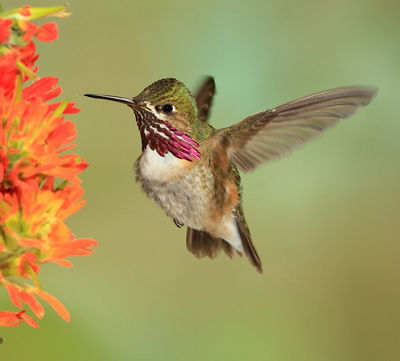
2. Allow a faster shutter speed and/or a lower, less noisy ISO. If photographing with a slow f/5.6 lens, perhaps the optimum exposure combination is ISO 1000, f/5.6, and 1/60th second. If the lens you were photographing with had a maximum aperture of f/2.8 instead (two stops faster), you could increase the shutter speed two stops to 1/250th second, or you could lower the ISO to ISO 250, or a combination of the two variables: perhaps 1/125th second, f/2.8, and ISO 500. Faster lenses give you more exposure options.
3. Easier to manually focus because the depth of field you see when focusing is so shallow and the viewfinder is brighter. In cases where manual focus works well, such as shooting through vegetation or heavily falling snow, faster lenses show a brighter view, and more shallow depth of field, making it easier to see when sharp focus is on the subject.
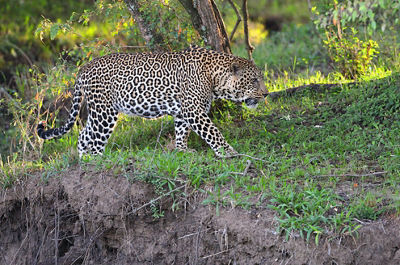
4. Permit lower ISOs to be used. Higher ISO values have steadily improved in digital photography. However, high ISOs may show visible “noise” that degrades the sharpness and color in the image. Fast lenses allow lower ISOs to be used in similar lighting conditions. For example, in deep shade or at dawn/dusk, an ISO of 6400 might be required to get a sufficiently fast shutter speed to allow an f/5.6 telephoto lens to be used. In the same conditions, a faster f/2.8 lens could shoot the same scene at ISO 1600 — generally delivering less noise and better image quality as a result.
5. When shot at the maximum lens aperture, the background is more out of focus. The f-stop on the lens is a major factor that determines the depth of field or the zone of sharp focus as it appears to us. Using more wide-open f-stops (f/2.8 or f/4.0) will show fewer distractions in the background because they are much more out of focus in the narrow depth of field zone.
Minimum Focus Distance
When it is possible to approach small animals, having a lens that focuses closely is enormously helpful. For example, I photograph many hummingbirds at distances of six to eight feet. If the minimum focusing distance of the lens is ten feet, then I cannot focus the hummingbirds at any distance closer than ten feet unless I insert an extension tube, such as the Canon 25mm tube, in the optical path between the camera and the lens. Generally, the longer the focal length, the greater the minimum focus distance.
Image Stabilization
With optical Image Stabilization, elements within the lens move as you move during hand-held photography or when shooting on a tripod that is trembling from high wind. Image stabilization helps you capture sharp images of the subject. Keep in mind that image stabilization only helps to reduce the effects of camera shake, but does nothing for freezing subject motion. For active subjects, you must use a fast shutter speed, use flash with short flash durations, pan with the subject, or a combination of all three of these factors to capture sharp images. Image stabilization helps a lot especially when using slower shutter speeds. Always keep in mind, though, the key to truly sharp animal images includes three factors:
1. Focus on the animal’s face or eyes if possible
2. Keep the shutter speed up
3. Use superb photo techniques
Lens Hood
Sharpness, color, and clarity are improved by always using a lens hood that’s designed for the lens. The lens hood reduces flare, which improves all three items I just mentioned, and protects the lens from raindrops and may cushion the precious glass elements in the lens should it be dropped. No matter what lens I use, I always have the lens hood properly mounted on it. Canon’s L-series lenses either ship with an accessory lens hood, or have a built-in hood. Lens hoods are optional accessories for other Canon-brand lenses — but they’re a worthwhile and recommended investment.
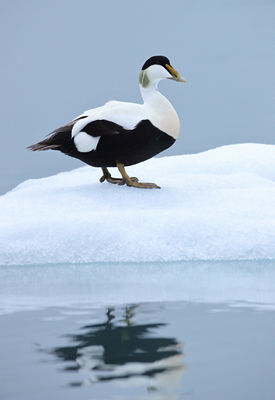
Canon 1.4x and 2x Extenders
Canon produces high-quality 1.4x and 2x extenders (often called tele extenders, or tele converters) that match their lenses beautifully. The extender is a small lens-like device with optical glass that multiplies the focal length of the lens by the power of the extender. For example, a 300mm f/4.0 lens optically becomes a 420mm f/5.6 lens when the 1.4x extender is inserted between the camera and the rear lens mount. If the 2x extender is used, then the 300mm f/4.0 lens effectively becomes a 600mm f/8.0. Notice extenders cost you some light. The 1.4x extender will cost you one stop of light and the 2x extender loses two stops of light. In effect, the lens speed slows down that much. Nevertheless, extenders are an excellent way to increase the focal length of the lens you already have, and the image quality is excellent if superb photography technique is used. Canon extenders are better than ever as they are now in their third generation!
Be aware that Canon-brand extenders are designed to work with specific compatible lenses only, as of early 2018:
- Any fixed focal length, L-series Canon lens — 135mm or longer
- Canon EF 70-200mm L-series zoom lenses — all f/2.8 and f/4.0 versions
- Canon EF 100-400mm L-series, IS zoom lenses — all versions
Lens Choices
Let’s explain some abbreviations first. Canon EF lenses are compatible with any Canon EOS digital SLR, regardless of whether it’s full-frame, or uses the smaller APS-C size image sensor. EF lenses can be used on compact EOS M-series cameras as well, with the optional Canon Mount Adapter EF-EOS M. EF-S lenses are exclusively for Canon EOS DSLRs with smaller APS-C type image sensors (again, they can be used on EOS M-series cameras with the optional EF-EOS M adapter). Either allows autofocus, or can be focused manually. IS refers to optical image stabilization. Canon has put some moving lens elements in these lenses to help you shoot sharp images if the camera moves a little when hand-held or wiggling on a tripod from the wind. USM means the focus is surprisingly fast due to the ultrasonic motor in the lens. L means special high-performance optical elements are used in the lens to improve sharpness, contrast and color rendition.
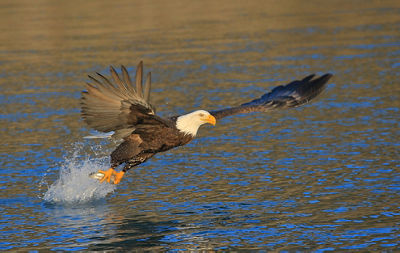
Canon EF 70-300mm f/4-5.6 USM IS II USM
If you're just getting started in shooting nature, this is a very affordable and practical lens option. It's the latest version of the lightweight 70-300 class zooms from Canon, and it's especially impressive in terms of its focus performance. It's also quite sharp, and offers very good close-focus capabilities (down to less than 4 feet, or 1.2m) when you can approach your subjects. Its Image Stabilization system can detect when you're panning to follow a moving subject, like birds in flight, and can automatically change the IS to correct for any shake perpendicular to your panning movement. Used on a camera like an EOS 80D or 7D-series model, it effectively gives you the same coverage as a 112-480mm lens would on a full-frame camera body. This lens is a great way to enter the world of telephoto wildlife and nature photography.
Canon EF 70-300mm f/4.5-5.6L IS USM
This is a fine option for those who shoot with cameras that offer the crop factor and don’t want to ding their credit card as much. With a camera that has a 1.6x crop factor due to the smaller sensor, the lens has a field of view like it was a 112-480mm f/4.5-5.6 lens and it does not lose any lens speed. It’s sharp, and significantly smaller than (for example) the 100-400mm design. That is awesome!
Canon EF 300mm f/2.8L IS II USM
This is a fabulous lens when shooting in dim light due to the f/2.8 lens speed. Many sports photographers use it for that reason, but wildlife shooters love it too, and with extenders it is even more versatile. A 1.4x extender makes the lens a 420mm f/4.0 and the 2x extender makes it a quality 600mm f/5.6 lens that can focus quite close. It works beautifully on a monopod, and can be hand-held as well — its image stabilization is a big help here.
Canon EF 300mm f/4.0 L IS USM
Much smaller and far more budget friendly is this 300mm lens that is only one stop slower than the f/2.8 version. I have used this lens a lot over my forty-year career with excellent results. When used with a 1.4x extender, it becomes a quality 420mm f/5.6 lens that still retains its autofocus. And used with a camera that has a 1.6x crop factor, this lens now has the reach and field of view of a (420mm x 1.6) 672mm telephoto! Its close-focus capabilities are excellent, too.
Canon EF 100-400mm f/4.5-5.6L IS II USM
This is a superb lens for wildlife, especially in Africa when confined to a safari vehicle or anywhere when shooting from a photo hide. The ability to change focal lengths quickly is of tremendous help when subjects are well within the longest 400mm focal length. Version II is highly praised by wildlife photographers around the world. For many wildlife photographers, this is the best option for covering their wildlife photo needs, especially those using cameras with a 1.6x crop factor. Then the lens offers the field of view effectively similar to a 160-640mm f/4.5-5.6L IS II USM lens. This is an excellent focal length range for wildlife, and again, it’s a lens that can be hand-held.
Canon EF 400mm f/2.8L IS USM
A big and expensive lens, having a lens speed of f/2.8 in a 400mm focal length is awesome when photography must be done under dim lighting conditions. Naturally, this lens accepts Canon’s 1.4x and 2x extenders to increase the focal length to 560mm or 800mm respectively.
Canon EF 400mm f/4.0 DO IS II USM
This light lens makes it especially appealing to those who don’t want to carry the weight of a big telephoto and prefer to shoot hand-held where its built-in image stabilization is greatly appreciated. This and the next lens are both excellent for hand-held flight photography because they offer good magnification in a lens that is light enough to hand-hold easily.
Canon EF 400mm f/5.6L USM
Lens speed (f/2.8 or f/4) is important to wildlife photographers in dim light. However, this f/5.6 lens is far less expensive and quite useable with cameras that offer low noise at high ISOs. Due to the steadily improving quality of higher ISO’s in new cameras, a lens with a maximum f/5.6 lens speed is no longer at a serious disadvantage. By the way, I have had clients use this lens that focuses as close as 11.5 feet for hummingbirds at my workshops, and it performed flawlessly. I am considering getting one for hummingbird photography myself! And with a camera that has a smaller sensor 1.6x crop factor, it produces an angle of view like a (400mm x 1.6) 640mm lens. This lens weighs much less and costs far less than a true 600mm f/4.0 lens, so it is an excellent option for many.
Canon EF 200-400mm f/4.0 IS USM with Extender 1.4x
I have led at least forty wildlife photo safaris to the best wildlife parks in Kenya. From years of experience, I know this is the best safari lens ever made. Shooting from a vehicle, it is incredibly helpful to be able to zoom the lens fairly wide, such as 200mm for elephants, and then zoom to 400mm for smaller animals like warthogs or jackals. With the built-in 1.4x extender, simply flipping a switch to insert the converter into the optical path makes this lens reach all the way out to 560mm! Having every focal length available between 200mm and 560mm in one lens is enormously useful. And with the cameras that have the 1.6x crop factor, it effectively covers the range of 320-896mm!
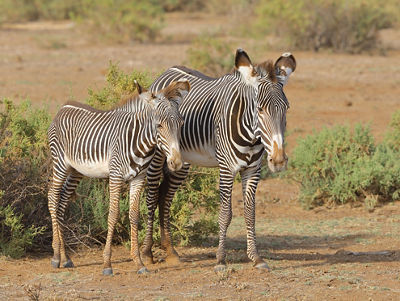
Canon EF 500mm f/4L IS II USM
I have used various versions of Canon’s 500mm lens for decades. The 500mm is terrific for wildlife where the subject is somewhat wary and must be approached slowly and carefully. The extra working distance of this lens makes it so much easier to fill the image more with subject. Though big, the lens isn’t that difficult to carry and use on a tripod. And with the 1.4x extender, it becomes a powerful 700mm f/5.6 lens.
Canon EF 600mm/4 L IS II USM
I have never owned this lens because it is larger and heavier than the 500mm. But it is superb! If wildlife was my only interest in photography, I would have bought this lens right away. Coupled with Canon’s 1.4x extender, this lens becomes an awesome 840mm f/5.6 lens! This is a powerful combination for serious wildlife photographers who need the reach of a super-telephoto lens and they should seriously consider getting it.
Canon EF 800mm/5.6 L IS USM
I have been using this lens for several years to obtain more telephoto power for much of my wildlife photography. This includes shooting from a vehicle and floating blind photography. I sold my 500mm lens when I bought this one and never regretted it. It really is true that seldom do you have too much focal length when photographing wildlife. Nearly always more magnification is better, to allow you to stay further away from the subject to avoid frightening it away.
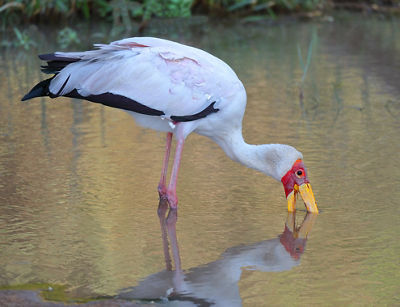
My Choices
I use full-frame cameras that include Canon’s EOS-1D X Mark II and the 5D Mark IV. The bulk of my wildlife photography is done with two Canon lenses today — the 200-400mm f/4.0 and the 800mm f/5.6 lens. That said, if I could pick again, I would certainly opt for Canon’s 200-400mm, but I think I would now go with the 600mm along with the 1.4x extender, as 840mm is a little more reach than 800mm — and, it can be “converted” to a faster f/4.0 lens for low-light, by removing the extender. And while I am dreaming, I really would like the 400mm f/5.6 for hand-held wildlife photography from boats, birds in flight, and my precious hummingbirds!
Since my cameras don’t have a small sensor, and therefore no crop factor, I need focal length to get a large image of the animals I photograph. I prefer the larger sensor cameras for three major reasons. First, sometimes animals approach me too closely. If I had a 1.6x crop factor, then I might have to cut off important parts of the subject. If the animal is too small in the final image, I can easily crop the image later with Canon’s DPP free RAW conversion software to usually make the subject larger in the image. Second, large sensor cameras tend to deliver better image quality at high ISOs because the pixels are larger. And third, wide-angle lenses remain wide with the full-size 36 x 24mm sensors.
No matter what Canon lens you use, terrific results are well within your reach. Slow down, develop superb camera and lens handling skills, enjoy your time with wildlife, and share your spectacular photos with the world!




